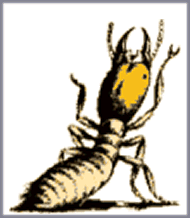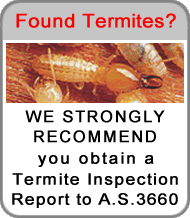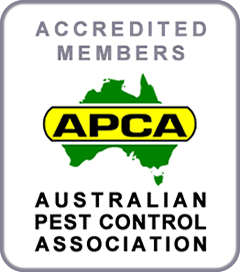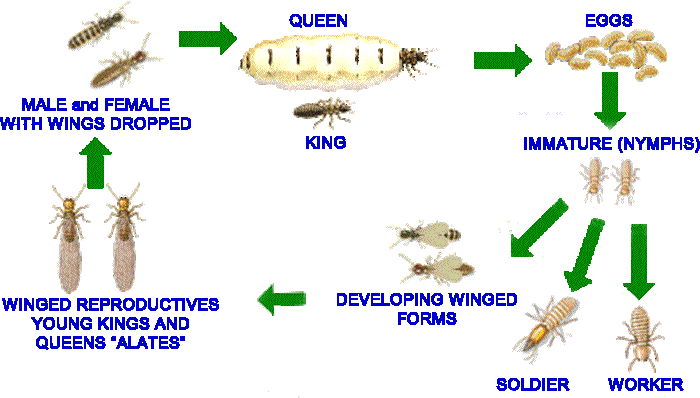 |
 |
 |
|
|
|||||||||||||||||||||||||
| Destructive "White-Ants" Pest Control Guide |
| White-Ants Pest Control Guide to the main destructive white-ant species in Australia; your pest control options and consumer protection advice.
Subterranean termites are also called "WHITE-ANTS" in Australia are a highly destructive timber pest, causing major structural timber damage to buildings. Recent APCA Industry surveys suggest about one in four of unprotected properties in Australia will be attacked by subterranean termites (white-ants) during the life of the building. Severe structural timber damage to Australian homes is on the increase due to more homes being built of materials and designs that encourage hidden termite entry and infestation.
White Ants have a Central Colony - Subterranean Termites aka "White-ants" build a central colony nest from which they construct underground tunnels that radiate through the soil in about a 100 metre radius in search of cellulose timber food sources ... maybe your home.
The smallest of gaps white-ants can pass through a 2 mm crack or expansion joint eating through rubber compound between adjoining concrete (on ground)n flooring. White-ants often travel under parquetry and floor tiles to get to the wall framing timbers. |
||||||||
| White-Ants digestive system, turns timber into a liquid food source |
Worker white-ants digest timber by the use of symbiotic protozoa in their gut. Worker white-ants feed their partly digested semi-liquid food, regurgitated from their mouth or passing from their anus, to the other white-ants, a process known as trophallaxis.
Hi-tech baits for white-ants were recently introduced into the Australian market from the USA which have a delayed lethal effect on white-ants. The bait is readily passed to other white-ants in the central colony nest during their mutual grooming and feeding.
|
||||||
| The facinating biology of Australian white-ants |
|
White-ants are not "ants" at all - white-ants are ground dwelling timber eating insects originating from prehistoric cockroaches. The oldest termite ever found was in Arizona preserved in amber fluid and dated at 220 million years old (been dead along time!).
Interdependent caste system within a white-ant nest there are members of different castes, each with a different role but interdependent role to perform including the queen, king, the winged swarmer or reproductive (young king and queen), soldiers and workers.
|
| The life cycle and habits of Australian White-Ants |
 White-ants constantly groom and feed each other. A valuable technique for the white-ant pest controller is to instal and monitor a white-ant termite baiting system next to any live activity found in and around the premises where white-ants are foraging. Subsequent inspections (preferably monthly) may reveal dead or sick worker white-ants, they change colour to a mottle look as they spread the white-ant bait to other white-ants leading to the eventual elimination of the entire white-ant colony ... more details. White-ant baits are designed to be non-repellant to the white-ants and has a unique delayed effect. Time enough for the poison to be passed onto other white-ants in the colony including the queen. With a sufficient dosage taken back to the nest can lead to the elimination of the entire white-ant colony ... more details. |
||
| The main destructive species of Australian Termites "White Ants" |
| It is essential for the white ant inspector to properly identify the species of white ant found in a building or surrounds. Some white ant species will not attack dry seasoned timbers, whilst others are highly destructive to building timbers in a short amount of time.
Coptotermes acinaciformis Commonly found throughout Australia - particularly in urban areas or where eucalypt gum trees are highly prevalent.
White-ant nest Location - Coptotermes acinaciformis are a very secretive timber pest - they build their nest out of sight, often within the base of eucalyptus or other susceptible trees, or completely under the ground - often within an enclosed patio or under concrete on ground flooring which is ideal for moisture retention, temperature and humidity control within the white ant colony's central nest. Coptotermes acinaciformis white-ants may construct subsidiary white-ant colony nests away from the main colony nest. A subsidiary white-ant nest are often found in a wall cavity of a building where there is a reliable moisture source, for example, from a leaking shower recess or faulty guttering or rusted down pipes. Mastotermes darwiniensis Area of Distribution - Commonly found in tropical Queensland, Northern Territory and Western Australia - generally north of the tropic of Capricorn.
White-ant nest location - Mastotermes darwiniensis white-ants build their nest (secretively) totally below the soil surface; or in the trunks and root crowns of trees and stumps. Once a nest is mature (over 100,000 or much higher) they can 'split off' to form other nests over a wide ranging area. These sub nests are formed constantly and can sustain life for along period of time without contact to the original nest. Schedorhinotermes intermedius Area of Distribution - Commonly found in eastern NSW and south eastern Queensland - particularly along the entire coast-line, the Great Dividing Range and adjoining slopes.
Destructive Nature - Schedorhinotermes intermedius white-ants are highly destructive to buildings and timber structures. If mostly major (larger) soldiers are sighted it is a large colony with the potential to cause severe and rapid damage to structural timbers of a building or other timber structures. White-ant nest location - Schedorhinotermes intermedius white-ants often build their nest in tree stumps, in root crown of living, dead and debilitated trees, under houses or enclosed patios or areas where timber has been buried or stored in contact with the soil. Coptotermes frenchi Area of Distribution - Commonly found throughout NSW, ACT, Victoria and south eastern South Australia; particularly in urban areas, where buildings are constructed of softwood or oregon timber framing. This species is responsible for most of the timber pest damage to buildings in the ACT region. Destructive Nature - Coptotermes frenchi white-ants can cause severe damage to buildings and other wooden structures. It is common for this species to devour timber framing leaving only a thin veneer. This species is the most shy of the destructive species; they will retreat from a location immediately (for the time being) if disturbed. Nest Location - Coptotermes frenchi white-ants most often build their nest in the root crown or lower trunk area of living trees, particularly eucalypts. They may also build their nest as a mound in the dryer areas. Nasutitermes exitiosus
Destructive Nature - Nasutitermes exitiosus white-ants are destructive to buildings and other timber structures. Sometimes severe damage may occur, but not so commonly as the other species listed above. White-ant nest location - Nasutitermes exitiosus white-ants build a mound nest which protrudes 30cm to 75cm above the ground. Control can be as easy as knocking the top off the nest and a follow up insecticide treatment inside the nest. Coptotermes lacteus
Destructive Nature - Coptotermes lacteus white-ants attack stumps, dead trees, timber fences, poles and other timber structures that are in contact with the soil, being softened by weathering or decay. These white ants are also known to attack such timber in damp sub-floor areas. White-ant nest location - this white ant species, most often builds it's nest as a mound up to 2m above ground level, with hard clay walls, so control is easily effected once located by knocking the top off and insecticide treatment of the nest. Nasutitermes walkeri
Destructive Nature - Nasutitermes walkeri white-ants can be destructive to damp timbers often a serious problem where the sub-floor of a building is damp and ventilation is poor with resulting wood decay or fungal growth. White-ant nest location - Nasutitermes walkeri white-ants build their nest in trees on main trunk or fork of a large branch. Heterotermes ferox Area of Distribution - Commonly found throughout NSW, the ACT, Victoria, and southern parts of South Australia and Western Australia - particularly in urban areas or where eucalypt gum trees are highly prevalent.
White-ant nest locationn - Heterotermes ferox white-ants may build their nest in stumps, logs, or other timber in direct contact with soil if some wood decay or rotting is prevalent. Dampwood white ants form small independent nests which often attack sick or dead trees, decaying stumps or mouldy timber in the ground; they are seldom found in dry timbers in buildings. Drywood white ants occur mostly in tropical areas, where atmospheric humidity is constantly above 75%. The introduced and highly destructive West Indian drywood white ant, Cryptotermes brevis, is rarely located in NSW, once in Sydney in the early 1980's. Specialist eradication procedures involve wrapping the entire building in plastic and using methyl bromide fumigation. |
||||||||||||||||
| If you find white-ants do NOT disturb them |
| Termites "white-ants" have acute survival instincts - if severely shaken up or disturbed the termites or white-ants will often abandon that particular area and move on to other unknown areas of the building where you cannot see them.
If you find termites "white-ants" in or around your property, it is essential that you do NOT disturb them and promptly arrange for a professional inspection to AS 3660. To find out about your Termite Control Options - click here |
||
|
|||||||||||||||||||||||||
             
|
| Published by the Fumapest Group © Copyright 1995 to - updated |